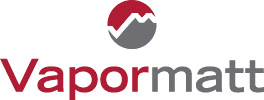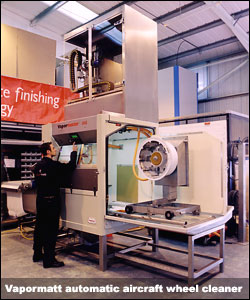Vapormatt has introduced an automated machine – the ‘Cougar’ – for the cleaning, degreasing and complete de-painting, when required, of aircraft wheels during regular inspection and maintenance operations.
No solvents or hazardous chemicals are used in the machine, which can be employed for wheel cleaning/degreasing alone or for concurrent cleaning and de-painting in the same process chamber – this eliminates the time-consuming loading and unloading of wheels necessary with conventional equipment. In addition, because the new machine operates automatically, once set-up it requires only minimal supervision.
Based on the company’s existing dust-free ‘Water-Assisted Stripping Process’ (‘WASP’) technology, the Cougar features adjustable blast nozzles, enabling the operation to be programmed to cater for different wheel designs in diameters of up to 27in (685mm).
WASP utilises proven wet blasting techniques and is a self-contained process employing an operator-safe cleaning solution comprising a special mix of water, detergent and “soft” plastic media. This is projected under pressure at the wheel by the blast nozzles, which can be configured to optimise the surface coverage of each particular wheel shape and size. The wheel itself is located onto a vertical, variable-speed rotating fixture attached to a bogie, which transports it into and out of the sealed processing enclosure. Processing parameters are pre-programmed via a “user-friendly” control panel.
The operating pressure of the process is highly controllable, enabling it to be adjusted precisely either for cleaning/degreasing or the complete de-painting of wheels. When used at low pressure, the process does not damage coated or anodised substrates, removing grease, oil, carbon and brake dust deposits quickly and effectively. Basically, it simulates hand scrubbing but without the laborious manual effort.
Used at higher pressures, the WASP process provides rapid, simultaneous, paint stripping and contamination removal – again with no substrate damage. Effluent from the machine is processed through a filtration system, which separates out solid waste for safe disposal and allows the water to be recycled.
Because no solvents or other potentially hazardous chemicals are required, the machine is not subject to stringent EU solvent emission, VOC or dust emission legislation.























